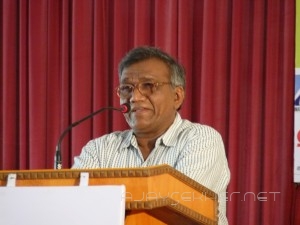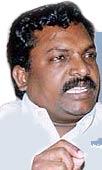Anand Teltumbde
(From ‘Dalit Rights‘ blog)
During the state sponsored carnage of Muslims in 2002, Dalits in Gujarat were unduly defamed having performed the role of foot soldiers of the Hindutva forces. These were stray incidents in Ahmedabad wherein Dalits were spotted in the crowds that attacked Muslims but there were several other instances that surfaced later all over the state in which Dalits had sheltered Muslim families daring the Hindutva marauders. But media in its characteristic way sensationalized the former and completely ignored the latter. Dalits who are always seen with jaundiced eye, became more despicable because of this canard. Intellectuals and commentators waxed eloquent for years thereafter in their stereotypical analyses of what appeared as sinister development without caring for the facts. These highbrow analyses feigning empathy and concern for Dalits only served to deepen hatred for them. In this negativity lay a positive implication that the upper castes and Dalits might henceforth have amicable relations in Gujarat eliminating the possibility of any caste conflict in the future. Mere glance at the facts would show how removed these commonplace notions and intellectual commentaries were from the ground reality in Gujarat.
The recent incident in Thangadh, a small town in Surendranagar district of Gujarat, in which three Dalit youth lost their lives as fallout of a minor clash between them and an upper caste community called Bharwad is a case in point. The clash occurred as a result of an argument over auctioning of stalls at an annual fair organized by the Thangadh municipality. According to newspapers, a Dalit youth was beaten up by the Bharwads on Friday after which the Dalits filed a complaint against them with the Thangadh police station. The following night, the two groups clashed near the police station. The local Police intervened and fired upon the crowd seriously injuring a 16-year old boy Pankaj Amarsi Sumra, who later died in a hospital in Rajkot. News of the death sparked outrage among Dalits in Thangadh who took to the streets demanding that a complaint be filed against police officials responsible for the death. With tension in the town, police officials called in reinforcements. On Sunday afternoon the police again opened fire on the agitating Dalits injuring three Dalit youths. They were rushed to the Rajkot civil hospital where Mehul Rathod, 17, and Prakash Parmar, 26, died. The condition of the third, Chhana Vaniya, 25, was critical.
These are the broad facts of the case. The incident is reminiscent of a similar incident that took place in Paramkudi, a taluka place in Ramnathpuram district in distant Tamilnadu poignantly pointing to the pan Indian reality of caste conflict, and that the situation in Gujarat was no different than the atrocity prone Southern Tamilnadu. In Paramkudi, there was a long history of conflict between Pallar, a second most populous Dalit community and the Thevar, the local upper caste community not very dissimilar to Bharwad in the instant case. Other details of these two cases run strikingly similar [see, Author’s report of the fact finding: Killing Pallars To Propitiate Thevars, available online] As in the Thangadh incident, a 16-year old Dalit boy was hacked to death by a group of Thevars on the previous day, in a nearby village. The next day, large number of Dalits gathered at Paramakudi as planned to pay homage to their leader, Emanuel Sekaran, at his memorial on his birth anniversary. Emanuel Sekaran was brutally murdered 54 years ago in a conflict with Muthuramalinga Thevar, the leader of Thevars, whose memorials and anniversaries are patronized by the state. Although Dalits knew about this murder, they had maintained normalcy required for the solemnity of the occasion. However, the unusually huge police posse positioned there indicated that the state had different plans for the day. The plan unfolded into police suddenly opening fire and unleashing brutal atrocities over the day eventually killing in all six Dalits and injuring scores of them.
The similarities between Than and Paramakudi go beyond these incidents. Bharwad community in Gujarat is not highly positioned to be called an upper caste. Traditionally its vocation was shepherding and still it is predominantly pastoral, only a small section of it being agriculturists and significant numbers being farm labourer. They are so backward that a section of them living on the edge of the Gir forest rather are included into Scheduled Tribe. Likewise, Thevars also are not placed high in caste hierarchy and were almost at the lower end of the shudra band. So much so that in colonial times they were classed as the criminal tribes by the colonial rulers. There is a profound lesson contained in these episodes like numerous others that today the conflict of Dalits is not with the well entrenched upper castes, habitually identified with Brahmins by Dalits but with these backward castes, whom they fondly include as their allies in constructing ‘bahujan’. In both cases a teenage Dalit boy is murdered on the previous day (coincidently Saturday) and the police firing takes place on Sunday resulting into a major toll of Dalit lives. The police bias in both the cases is palpable, and is responsible for the bloodshed. Massive Dalit protests that followed these incidents led by social activists and not by the mainstream leaders also was a common feature across both.
In such incidents, the police come out with their own stories to justify their actions. As in Paramakudi, the Police in Thangadh claimed that both sides clashed with sticks and sharp weapons on Saturday and hence they had to intervene. They claimed to have used tear gas shells before a sub-inspector K P Jadeja opened fire. The activists denied it and claimed that Jadeja fired without any warning whatsoever and only at Dalits. Proof of the pudding bears out their version as there was no injury on Bharwad side. Moreover, after the skirmish between two communities the police had suspended the fair and there was no reason for firing at 11.30 in night on people who were returning home. The activists claimed that Jadeja did it only with casteist prejudice against Dalits. On Sunday afternoon, the police claimed that the angry Dalits clashed with Police and hence they had to open fire in self defence. The CID investigation, ordered by the government in response to the massive agitation Dalits proved that it was a pure lie.
Another stratagem common to all such incidents is Police arresting Dalits and slapping cases on them, with serious charges like attempt to murder. In the infamous incident of police gunning down 10 Dalits in Ramabai Nagar in Mumbai in 1997, while the sub inspector Manohar Kadam, whose guilt was variously proved not only in the courts but also by the Gundewar Commission instituted by the Maharashtra government to probe the matter, never went to jail and was rather rewarded with promotions, the Dalit boys who protested against the police firing were harassed for more than a decade fighting cases against them until the court acquitted them. In Thangadh also the Police arrested Dalit boys and slapped serious charges against them. It is only because of the intensity of protest Dalits displayed that the government has relented and released them. Notwithstanding the fact that it is an election year and Narendra Modi would ill afford to displease Dalits by not conceding their reasonable demand, the credit still goes to Rajesh Solanki (Raju) of the Council for Social Justice (CSJ) for mobilizing people around it in an unprecedented manner.
The Thangadh episode surely refutes the negative characterization of Dalits of Gujarat that they patched up with the rightist forces. It also exposes the hollow claims of Narendra Modi that his regime takes good care of Dalits, Adivasis and even minorities. The matter of Adivasis, who have been Hinduised over the years is well known to people and what his regime did to the Muslims is still getting exposed through courts. Dalits were the only people whose contradictions with the regime had not come so much in limelight, notwithstanding the ongoing struggle of the veteran activist Valjibhai Patel of the CSJ. If one takes a look at the atrocity statistics, the Modi regime only scores average among the states and union territories ranking tenth highest in the list of 35. As per the Crime in India 2011 report, there have been 1063 registered crimes against Dalits in Gujarat in which there were 12 murders and 45 rapes. Modi’s hyperbole about Dalits in Gujarat turns out as hollow as his developmental claims. He will have to account for the blood of Dalits spilled in Gujarat quite like anyone of his ilk elsewhere.
(Dr Anand Teltumbde is a writer and civil rights activist with CPDR, Mumbai.)
~~~
[Courtesy: Dalit Rights, October 26, 2012]









